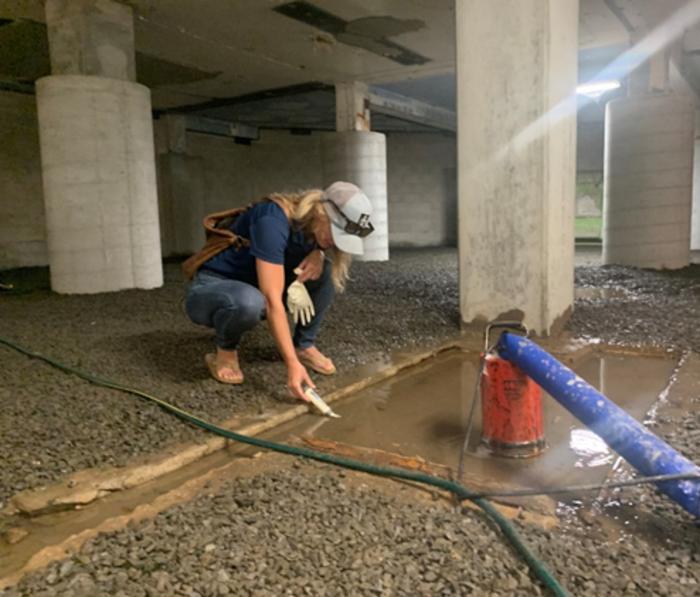Hidden threat: Global underground infrastructure vulnerable to sea-level rise
As sea levels rise, coastal groundwater is lifted closer to the ground surface while also becoming saltier and more corrosive. A recent study by earth scientists at the University of Hawai‘i (UH) at Mānoa compiled research from experts worldwide showing that in cities where there are complex networks of buried and partially buried infrastructure, interaction […]

As sea levels rise, coastal groundwater is lifted closer to the ground surface while also becoming saltier and more corrosive. A recent study by earth scientists at the University of Hawai‘i (UH) at Mānoa compiled research from experts worldwide showing that in cities where there are complex networks of buried and partially buried infrastructure, interaction with this shallower and saltier groundwater exacerbates corrosion and failure of critical systems such as sewer lines, roadways, and building foundations.

Credit: Chloe Obara, University of Hawai’i
As sea levels rise, coastal groundwater is lifted closer to the ground surface while also becoming saltier and more corrosive. A recent study by earth scientists at the University of Hawai‘i (UH) at Mānoa compiled research from experts worldwide showing that in cities where there are complex networks of buried and partially buried infrastructure, interaction with this shallower and saltier groundwater exacerbates corrosion and failure of critical systems such as sewer lines, roadways, and building foundations.
“While it has been recognized that shallowing groundwater will eventually result in chronic flooding as it surfaces, what’s less known is that it can start causing problems decades beforehand as groundwater interacts with buried infrastructure,” said Shellie Habel, lead author and coastal geologist in the School of Ocean and Earth Science and Technology (SOEST) at UH Mānoa. “This knowledge gap often results in coastal groundwater changes being fully overlooked in infrastructure planning.”
The research team aimed to create awareness about these issues and offer guidance from world experts on managing them. Habel and co-authors reviewed existing literature to examine the diverse effects on different types of infrastructure. Additionally, by employing worldwide elevation data and geospatial data that indicate the extent of urban development, they identified 1,546 low-lying coastal cities and towns globally, where around 1.42 billion people live, that are likely experiencing these impacts.
“The IPCC 6th Assessment Report tells us that sea level rise is an unstoppable and irreversible reality for centuries to millennia,” said Chip Fletcher, study co-author, interim Dean of SOEST, and director of the Climate Resilience Collaborative (CRC) at UH Mānoa. “Now is the time to prepare for the challenges posed by this problem by redesigning our communities for greater resilience and social equity.”
Concealed damage
Well before the visible effects of surface flooding, sea-level rise pushes up the water table and shifts salty water landward. With this, the subsurface environment becomes more corrosive to critical underground infrastructure networks—buried drainage and sewage lines can become compromised and mobilize urban contamination, and building foundations can weaken.
Extensive research conducted by the CRC has substantiated that critical infrastructure around the world, including drainage and basements, is likely currently experiencing flooding from rising groundwater levels.
“The damage caused by sea level rise-influenced coastal groundwater is often concealed and not immediately perceptible,” said Habel, who is based at the CRC and Hawai‘i Sea Grant in SOEST. “As a result, it tends to be overlooked in infrastructure management and planning efforts.”
Informing management strategies
The study authors emphasize the importance of research efforts that can contribute to informed adaptation strategies.
“Being aware of these hidden impacts of sea level rise is of significant importance for the State of Hawai‘i due to the concentration of communities situated along low-lying coastal zones where groundwater is generally very shallow,” said Habel.
The CRC actively collaborates with partners across the nation and infrastructure managers in Hawai‘i to gain a comprehensive assessment of how vital infrastructure, encompassing pipe networks, roadways, and buildings, is impacted. Understanding the impacts and risks associated with sea level rise-influenced coastal groundwater enables more effective management and adaptation.
Journal
Annual Review of Marine Science
DOI
10.1146/annurev-marine-020923-120737
Method of Research
Data/statistical analysis
Subject of Research
Not applicable
Article Title
Hidden Threat: The Influence of Sea-Level Rise on Coastal Groundwater and the Convergence of Impacts on Municipal Infrastructure
Article Publication Date
17-Jan-2024
COI Statement
The authors are not aware of any affiliations, memberships, funding, or financial holdings that
might be perceived as affecting the objectivity of this review.
What's Your Reaction?

































